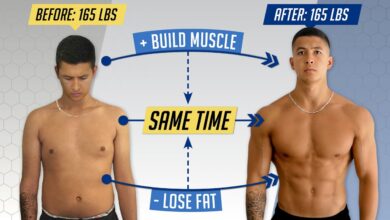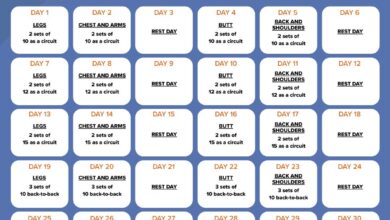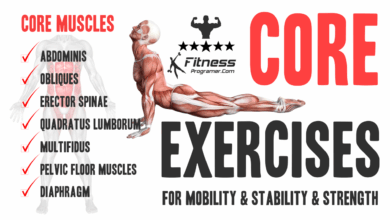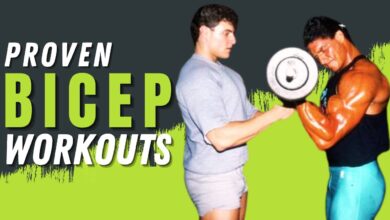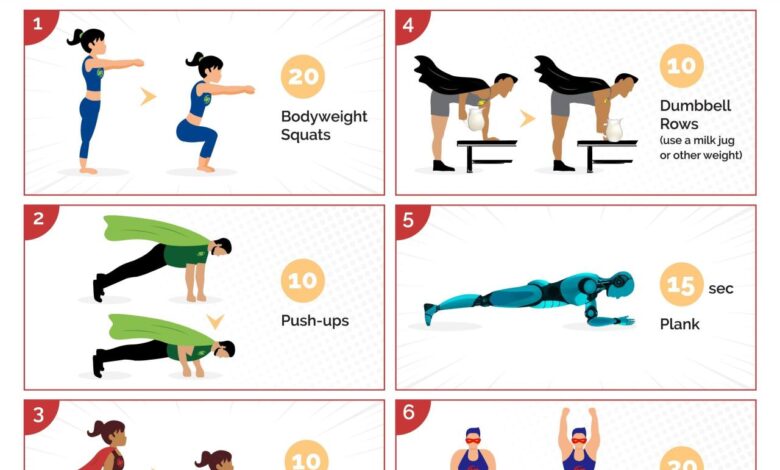
Home Bodyweight Workout 3: Build Strength Without Weights
Home Bodyweight Workout 3: Ready to take your fitness to the next level without stepping foot in a gym? This workout plan is designed to help you build strength, endurance, and flexibility using only your bodyweight. No fancy equipment or memberships needed, just you and your determination! We’ll explore a structured routine that targets different muscle groups, provides modifications for all fitness levels, and offers tips for maximizing your results.
Whether you’re a seasoned athlete or just starting your fitness journey, home bodyweight workouts offer a fantastic way to get in shape. They’re convenient, accessible, and surprisingly effective! We’ll delve into a variety of exercises, from classic push-ups to challenging plyometrics, and guide you through proper form and technique.
Get ready to unlock your potential and experience the power of bodyweight training!
Introduction to Home Bodyweight Workouts
Home bodyweight workouts offer a convenient and effective way to improve fitness and overall well-being. They require minimal equipment and can be performed anywhere, making them an accessible option for people of all fitness levels.
Benefits of Home Bodyweight Workouts
Home bodyweight workouts provide numerous benefits, including:
- Improved Strength and Endurance:Bodyweight exercises engage multiple muscle groups simultaneously, promoting overall strength and muscular endurance.
- Enhanced Functional Fitness:These exercises mimic everyday movements, improving functional fitness and making daily activities easier.
- Increased Bone Density:Weight-bearing exercises, such as squats and lunges, can help increase bone density and reduce the risk of osteoporosis.
- Improved Cardiovascular Health:High-intensity bodyweight workouts can elevate heart rate and improve cardiovascular health.
- Reduced Risk of Injuries:Proper form and gradual progression can minimize the risk of injuries associated with traditional weightlifting.
- Convenience and Accessibility:Home bodyweight workouts require minimal equipment and can be done anywhere, making them convenient and accessible for everyone.
Equipment Required for a Home Bodyweight Workout
While bodyweight workouts primarily rely on your own body weight, some basic equipment can enhance the experience:
- Yoga Mat:Provides cushioning and support for exercises performed on the floor.
- Resistance Bands:Add resistance to exercises, making them more challenging and effective.
- Pull-Up Bar:Allows for upper body exercises like pull-ups and chin-ups.
- Suspension Trainer:Provides a versatile training tool for a wide range of exercises.
Examples of Home Bodyweight Exercises
A wide variety of exercises can be performed at home using only your body weight. Here are some examples categorized by muscle group:
Lower Body
- Squats:Work the quadriceps, hamstrings, and glutes.
- Lunges:Target the quadriceps, hamstrings, and glutes, improving balance and coordination.
- Calf Raises:Strengthen the calf muscles.
- Glute Bridges:Activate the glutes and hamstrings, improving hip extension.
Upper Body
- Push-Ups:Work the chest, shoulders, and triceps.
- Plank:Strengthen the core muscles, including the abs, back, and obliques.
- Dips:Target the triceps and chest.
- Pull-Ups:Engage the back, biceps, and forearms.
Core
- Crunches:Strengthen the abdominal muscles.
- Russian Twists:Work the obliques and core muscles.
- Leg Raises:Target the lower abdominal muscles.
- Bird Dog:Improve core stability and balance.
Workout Structure and Progression
A well-structured home bodyweight workout routine can effectively target different muscle groups, promote overall fitness, and enhance your strength and endurance. To achieve optimal results, it’s essential to understand the principles of workout structure and progression.
Sample 3-Day Home Bodyweight Workout Routine
This sample routine provides a basic framework for a 3-day home bodyweight workout. You can adjust it based on your fitness level and goals.
Home bodyweight workout 3 is all about building strength and endurance, but it’s also a great way to get ready for those Thanksgiving feasts! After all, you’ll want to be able to enjoy all the delicious food, and that means having a strong core and good balance.
If you’re looking for some inspiration for making your Thanksgiving table visually stunning, check out this article on 5 ways to fill your thanksgiving table with color. Once you’ve finished your workout, you’ll be ready to relax and enjoy a beautiful and delicious Thanksgiving meal.
- Day 1: Upper Body
- Push-ups: 3 sets of 8-12 repetitions
- Dips: 3 sets of 8-12 repetitions
- Pull-ups (or assisted pull-ups): 3 sets of as many repetitions as possible
- Plank: 3 sets of 30-60 seconds
- Day 2: Lower Body
- Squats: 3 sets of 10-15 repetitions
- Lunges: 3 sets of 10-15 repetitions per leg
- Calf raises: 3 sets of 15-20 repetitions
- Glute bridges: 3 sets of 10-15 repetitions
- Day 3: Full Body
- Burpees: 3 sets of 10-15 repetitions
- Mountain climbers: 3 sets of 30-60 seconds
- Jump squats: 3 sets of 8-12 repetitions
- Supermans: 3 sets of 10-15 repetitions
Structuring Workouts for Different Fitness Levels
- Beginner:Start with shorter workouts, 2-3 days per week, and focus on mastering proper form. Use easier variations of exercises, such as wall push-ups instead of regular push-ups. Choose exercises that challenge you but allow you to complete them with good form.
- Intermediate:Increase the intensity and volume of your workouts. You can do 3-4 days per week, including more challenging exercises and higher repetitions. Try incorporating advanced variations of exercises, like plyometric exercises or weighted squats.
- Advanced:Focus on building strength and endurance. You can train 4-5 days per week, including challenging exercises like handstand push-ups and muscle-ups. Incorporate progressive overload by increasing the weight or resistance you use.
Progression of Exercises
- Increase repetitions:Gradually increase the number of repetitions you perform for each exercise. As you get stronger, you’ll be able to do more repetitions. For example, if you start with 8 repetitions, you can gradually increase to 10, 12, and so on.
- Increase sets:Once you can comfortably complete the desired number of repetitions for each exercise, you can increase the number of sets. For example, if you start with 2 sets, you can increase to 3 sets and so on.
- Decrease rest time:As you get stronger, you can decrease the amount of rest time between sets. This will increase the intensity of your workout. For example, if you start with 60 seconds of rest, you can gradually decrease to 45 seconds or 30 seconds.
- Increase difficulty:Once you can comfortably complete the desired number of repetitions and sets with good form, you can make the exercises more challenging. This can be done by using more challenging variations of the exercise, adding resistance bands, or incorporating plyometrics.
Common Home Bodyweight Exercises
Bodyweight exercises are a great way to get a full-body workout without any equipment. They are versatile, effective, and can be done anywhere, anytime. This section explores common bodyweight exercises categorized by muscle group, providing detailed descriptions, illustrations, and proper form and technique.
Exercises for the Upper Body, Home bodyweight workout 3
These exercises target the muscles of the chest, shoulders, back, and arms.
- Push-ups:Push-ups are a compound exercise that works multiple muscle groups, including the chest, shoulders, triceps, and core.
Proper Form:
Home bodyweight workout 3 is all about building strength and endurance. I’m not a huge fan of complicated routines, so I keep it simple with exercises like squats, lunges, and push-ups. After a good workout, I’m always craving a good meal, and I often find myself wondering, “Can pasta be healthy?” The answer, as I learned from this article , is a resounding yes! Of course, it’s all about choosing the right kind of pasta and pairing it with healthy ingredients.
Then, I can fuel my body for the next home bodyweight workout, feeling confident and ready to push myself further.
– Start in a plank position with your hands shoulder-width apart and your body in a straight line from head to heels.
– Lower your chest towards the floor, keeping your elbows close to your body.
– Push back up to the starting position.
Illustration:Imagine a person lying face down on the floor with their hands shoulder-width apart and their toes on the ground. Their body is in a straight line from head to heels. They are slowly lowering their chest towards the floor, keeping their elbows close to their body.
Their back is straight and their core is engaged. Once their chest touches the floor, they push back up to the starting position.
- Dips:Dips are a great exercise for targeting the triceps, chest, and shoulders.
Proper Form:
– Start with your hands shoulder-width apart on a bench or chair.
– Lower your body by bending your elbows, keeping your back straight.
– Push back up to the starting position.
Illustration:Imagine a person sitting on a bench with their hands shoulder-width apart on the edge of the bench. They are slowly lowering their body by bending their elbows, keeping their back straight and their core engaged. Once their chest touches the bench, they push back up to the starting position.
- Pull-ups:Pull-ups are a challenging exercise that works the back, biceps, and forearms.
Proper Form:
– Start with an overhand grip on a pull-up bar, slightly wider than shoulder-width apart.
– Hang from the bar with your arms fully extended.
– Pull yourself up until your chin is over the bar.
– Slowly lower yourself back down to the starting position.
After crushing my third home bodyweight workout, I’m ready for a reward! And what better way to celebrate than with some delicious, fall-flavored snacks? Trader Joe’s always has the best seasonal treats, so I’m heading there to stock up on some of their 8 RD approved pumpkin flavored snacks – gotta keep those gains coming! Then it’s back to my workout routine, feeling energized and ready to conquer the next challenge.
Illustration:Imagine a person hanging from a pull-up bar with their arms fully extended and an overhand grip. Their hands are slightly wider than shoulder-width apart. They are slowly pulling themselves up until their chin is over the bar. Their back is straight and their core is engaged.
Once their chin is over the bar, they slowly lower themselves back down to the starting position.
- Rows:Rows are a great exercise for targeting the back and biceps.
Proper Form:
– Start with your feet shoulder-width apart and your body leaning forward at a 45-degree angle.
– Reach down and grab a chair or a stable object with your hands shoulder-width apart.
– Pull your chest up towards the object, keeping your back straight.
– Slowly lower yourself back down to the starting position.
Illustration:Imagine a person standing with their feet shoulder-width apart and their body leaning forward at a 45-degree angle. They are reaching down and grabbing a chair with their hands shoulder-width apart. They are slowly pulling their chest up towards the chair, keeping their back straight and their core engaged.
Once their chest touches the chair, they slowly lower themselves back down to the starting position.
Motivation and Consistency: Home Bodyweight Workout 3
Staying motivated and consistent with home workouts can be a challenge, especially when you’re not surrounded by the energy of a gym or the guidance of a personal trainer. But with the right strategies and mindset, you can build a sustainable fitness routine that delivers results.
Strategies for Staying Motivated
Staying motivated with home workouts requires a blend of intrinsic and extrinsic factors. Here are some strategies that can help you stay engaged and committed:
- Set Realistic Goals:Start with achievable goals and gradually increase the intensity and duration of your workouts as you progress. Setting unrealistic goals can lead to discouragement and frustration. For example, instead of aiming to exercise for an hour every day, start with two 30-minute sessions a week and gradually increase the frequency and duration as you get stronger.
- Find a Workout Buddy:Having a workout partner can provide motivation, accountability, and a sense of camaraderie. Working out with someone else can make the process more enjoyable and help you stay on track. If you don’t have a workout buddy, consider joining online fitness communities or groups for support and encouragement.
- Make it Fun:Choose activities that you enjoy and that fit your personality. If you find your workouts boring or tedious, you’re less likely to stick with them. Experiment with different types of exercises, try new routines, and find ways to make your workouts more engaging.
For example, you could listen to your favorite music, watch a show, or listen to a podcast while you exercise.
- Track Your Progress:Keep a workout journal or use a fitness tracker to monitor your progress. Seeing your improvements over time can be a powerful motivator and help you stay committed to your fitness goals. Recording your workouts can also help you identify patterns and areas where you need to focus.
For example, you might notice that you’re more likely to skip workouts when you’re feeling stressed or tired. This awareness can help you develop strategies for staying on track even when life gets busy.
- Reward Yourself:Celebrate your accomplishments and reward yourself for staying consistent. This could be anything from a healthy meal to a new workout outfit. Rewarding yourself can help you stay motivated and reinforce positive habits. For example, if you manage to complete a challenging workout, you could reward yourself with a relaxing bath or a movie night.
Building Consistency
Consistency is key to achieving your fitness goals. Here are some tips for building a sustainable workout routine:
- Schedule Your Workouts:Treat your workouts like important appointments and schedule them into your day. This will help you make time for exercise and ensure that it doesn’t get pushed aside. For example, you could schedule your workouts for the same time each day or week, making it a non-negotiable part of your routine.
- Set Realistic Expectations:Don’t expect to become a fitness expert overnight. It takes time and effort to build a consistent workout routine. Start small and gradually increase the intensity and duration of your workouts as you progress. For example, you could start with two 15-minute workouts per week and gradually increase the duration and frequency of your workouts over time.
- Be Patient and Persistent:There will be days when you don’t feel like working out. But it’s important to stay patient and persistent. Remember why you started exercising in the first place and focus on the benefits of a healthy lifestyle. It’s also important to celebrate your successes, no matter how small they may seem.
For example, if you manage to complete a workout even when you’re feeling tired, give yourself a pat on the back. This will help you stay motivated and build momentum.
- Don’t Be Afraid to Modify:If you’re finding it difficult to stick to your workout routine, don’t be afraid to modify it. This could involve shortening your workouts, reducing the intensity, or changing the type of exercise you’re doing. The key is to find a routine that you can consistently stick with.
For example, if you’re finding it difficult to complete a full hour of exercise, try breaking it down into two 30-minute sessions. Or, if you’re finding a particular exercise too challenging, try a modified version or a different exercise altogether.
Overcoming Common Workout Challenges
Here’s a table outlining common workout challenges and strategies for overcoming them:
| Challenge | Solution |
|---|---|
| Lack of Time | Schedule short workouts into your day. Even 10-15 minutes of exercise can make a difference. |
| Lack of Motivation | Find a workout buddy, set realistic goals, and reward yourself for staying consistent. |
| Feeling Bored | Try new exercises, listen to music, watch a show, or listen to a podcast while you work out. |
| Feeling Sore | Listen to your body and rest when you need to. Warm up properly before each workout and cool down afterward. |
| Feeling Overwhelmed | Start small and gradually increase the intensity and duration of your workouts. Don’t be afraid to modify your routine as needed. |
Outcome Summary
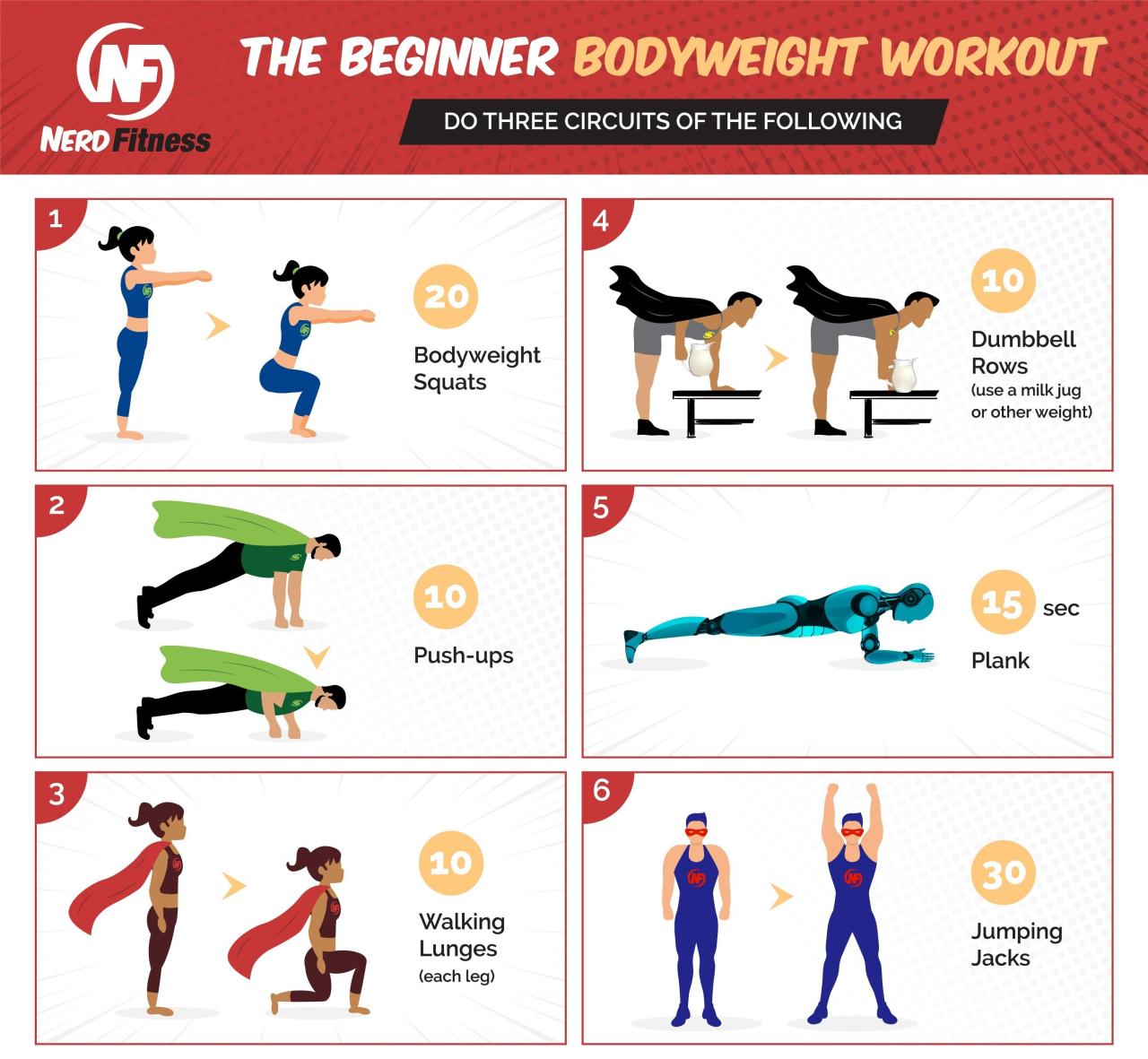
So, are you ready to embrace the challenge and unlock your full fitness potential? Home bodyweight workouts offer a versatile and rewarding path to a stronger, healthier you. Remember, consistency is key. Stick to the routine, listen to your body, and don’t be afraid to push yourself.
As you progress, you’ll witness remarkable transformations in your strength, endurance, and overall well-being. It’s time to step into your power and achieve your fitness goals with the simplicity and effectiveness of bodyweight training!

